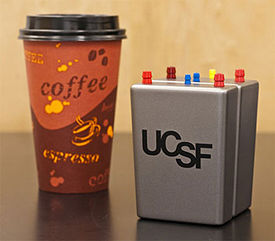Dialysis, by Kyle Reed: Difference between revisions
Kyle J. Reed (talk | contribs) No edit summary |
Kyle J. Reed (talk | contribs) No edit summary |
||
| Line 2: | Line 2: | ||
[[Image:Nephron.jpg|right|thumb|275px|Figure 1. Diagram of a nephron and the processes [1] ]] | [[Image:Nephron.jpg|right|thumb|275px|Figure 1. Diagram of a nephron and the processes [1] ]] | ||
The human kidney is an essential organ, playing vital roles in both the urinary and endocrine system. | |||
Revision as of 18:33, 6 February 2013
Background

The human kidney is an essential organ, playing vital roles in both the urinary and endocrine system.
History


Current Technology
There are two types of dialysis used to treat kidney renal failure, hemodialysis and peritoneal dialysis. Hemodialysis is performed on about 85% of patients, with the remainder being peritoneal dialysis [2].
Hemodialysis

Peritoneal Dialysis

Future of Dialysis


Nephron Regeneration
Human nephrons can only regenerate partially; they are not able to grow new ones. Fish are able to grow new nephrons however, and zebrafish have been extensively studied in order to try and emulate their kidney cells ability to self-replicate. Research has found that the zebrafish kidneys probably contains self-renewing nephron stem/progenitor cells. Future research into this field can allow scientists to try and replicate the growing of new nephrons in humans [10].
Artificial Kidney
There has been long debate about whether the technology would be created that will allow humans to bypass dialysis and "wear" a artificial kidney that is cheap in the near future [11]. The University of California, San Francisco (USCF) is looking to end that debate as soon as possible. They were able to create an artificial kidney that requires no power source and is projected to be equal or less in cost then a kidney transplant. It will have an operational lifetime of around a decade; it can filter blood and respond to some chemicals in the system with feedback. The first clinical trials for this device are planned for 2017, and the device itself is on a accelerated track for FDA approval [12]. (See source for video on the device).
Impact
It is apparent that the both of the research approaches described above can have a drastic impact on the lives of those that require dialysis. Whether it be allowing them to regrow an entire kidney, or have an artificial one instead, it would allow people to live their lives without the worries of having to spend countless hours near a dialysis machine to survive. However, these technologies could prove to be even more important for those that are not even able to have dialysis due to financial restrictions.
Figure 6 shows the global market for dialysis as of January 2013. The "Rest of World" portion has been amplified with the growing market in India. Currently, there are 52,000 Indian patients on dialysis, but this is no where near the amount of people that require it. While dialysis in India costs 4 to 33 percent of the cost in the U.S., more then 90 percent of the 230,000 that develop chronic kidney failure each year are unable to acquire treatment [13].
References
[1] Space Biomedical Research Institute. http://home.bway.net/rjnoonan/humans_in_space/fluid.html (accessed February 6, 2013).
[2] Ratner, B.D.; Hoffman, A.S.; Schoen, F.J.; Lemons, J.E. Biomaterials Science: An Introduction to Materials in Medicine, 2nd ed.; Elsevier Academic Press: San Diego, 2004; pp. 514-518.
[3] Saltzman, W. Tissue Engineering: Principles for the Design of Replacement Organs and Tissues; Oxford: New York, 2004; pp. 387-391.
X. The Kidney Doctor. http://www.thekidneydoctor.org/2012/02/remembering-willem-kolff.html (accessed February 6, 2013).
X. Advanced Renal Education Program. http://www.advancedrenaleducation.com/Hemodialysis/HistoryofHemodialysis/tabid/177/Default.aspx (accessed February 6, 2013).
X. DaVita. http://www.davita.com/kidney-disease/dialysis/motivational/the-history-of-dialysis/e/197 (accessed February 6, 2013).
X. $100 Dialysis. http://100dialysis.wordpress.com/2012/01/24/a-brave-beginning/ (accessed February 6, 2013).
[8] VascularWeb. http://www.vascularweb.org/vascularhealth/Pages/dialysis-access.aspx (accessed February 6, 2013).
[9] National Kidney and Urologic Diseases Information Clearinghouse. http://kidney.niddk.nih.gov/kudiseases/pubs/peritoneal/
[10] Diep, C.Q.; Ma, D.; Deo, R.C.; Holm, T.M.; Naylor, R.W.; Arora, N.; Wingert, R.A.; Bollig, F.; Djordjevic, G.; Lichman, B.; Zhu, H.; Ikenaga, T.; Ono, F.; Englert, C.; Cowan, C.A.; Hukriede, N.A.; Handin, R.I.; Davidson, A.J. Identification of adult nephron progenitors capable of kidney regeneration in zerbrafish. Nature. 2011, 470, 95-100.
[11] Ronco, C.; Davenport, A.; Gura, V. A wearable artificial kidney: dream or reality?. Nature Clinical Practice. 2008, 4, 604-605.
[12] medGadget. http://www.medgadget.com/2012/11/an-implantable-artificial-kidney-interview-with-ucsfs-dr-shuvo-roy.html (accessed February 6, 2013).
[13] The Kidney Doctor. http://www.thekidneydoctor.org/2013/01/global-nephrology-dialysis-in-india.html (accessed February 6, 2013).